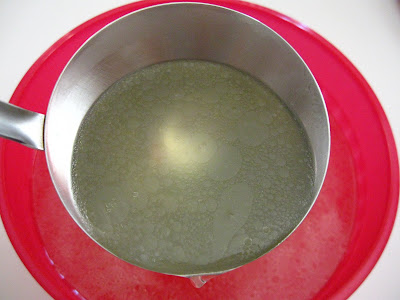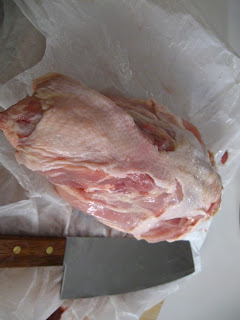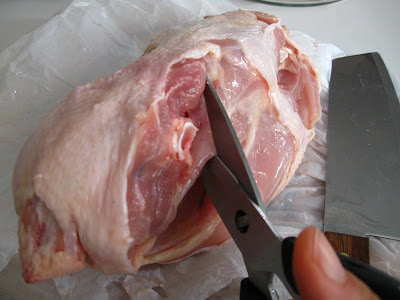The other day, I started to write about how to dissect a chicken and make stock, and though I would have liked to complete that post, I am often frustrated by how blogger inserts line breaks with no apparent rhyme or reason, ALL THE TIME. And because I'm in no position to replace this mac should I strangle it to death or throw it out the window in complete frustration, I give up. Fixing the convoluted html is not an option because as soon as you fix it on the back end, blogger goes in and inserts yet more line breaks, with yet more convoluted code, just because it can.
 |
| Caldo de Pollo... |
So while I'm deciding whether to move to a more predictable platform, if one exists, or to continue here and just figure out a workaround, I often publish my posts short of complete information to spare myself the consequences of First Degree Laptopslaughter.
But I digress...
... Mashed Potatoes...
|
But as with any debate that becomes academic, credible arguments are made from many sides. And a cook, especially one who writes about cooking, for practical purposes, has to draw lines in the sand for herself. So all those very detailed, valid and academic arguments included or aside, I tend to make the distinction between stock and broth in two related things:
1) the addition of salt, and
2) whether the flavor of the liquid is such that I could serve it as soup or consomme by itself.
And since I use my stock as a base or cooking liquid for soups, sauces and starches from a number of cuisines, I not only never salt my stock, but I barely flavor it with any other elements. And come to think of it, the more I use it, I less I am inclined to add anything but the bones, fat, skin and some flesh.
 |
| ... a super simple and lightly buttered risotto... |
 |
| ... even instant tom yum. All made richer and tastier with a little chicken stock. |
Sometimes I'll add an onion and maybe a single carrot, because onion is a truly ubiquitous ingredient throughout the world and because a single carrot lends some sweetness without too much distinct fragrance or flavor. In this particular series of pics, also one (and only one - a little goes a long way on my palate) stalk of celery. And that's only because celery gets such little play in my kitchen that a whole bunch, bought for the purpose of making potato salad, will never get used if I don't take every reasonable opportunity to use it. Finally, never any herbs. The simpler my stock, the more adaptable it is, and equally easy for me to use in a pot of pho broth, or tom kha gai, or chili, or risotto, or gravy... I could go on.
And as to the long simmer (3 or 4 hours is often prescribed), which results in a lot of collagen extraction, greater reduction of liquid and higher concentration of flavor, as well as a thicker, more gelatinous substance upon cooling, I prefer a relatively short simmer. No longer than an hour to an hour and fifteen minutes to simmer 8 cups of water down to roughly 6-ish cups of stock. No question you lose some richness, but that kind of richness doesn't work well with everything. And a thinner stock makes for something closer to a one-to-one substitution for water (not exactly, but closer). Not to mention the difference between one hour and three.
One last thing before I post the almost not recipe. I'm not much of an arm twister. I figure if someone wants to make stock, they're going to. But if I can cajole for a moment, I will say that there is a worthwhile difference in depth and complexity of flavor when you substitute some or all of the water in many soup or sauce recipes with stock. And I'll take it a step further to say that there is then another very worthwhile difference between the very simple, pure and unadulterated flavor you get from homemade stock and one that is made to withstand months, years even, on a shelf. So, with no further ado, I release your arm and present you my barely recipe for chicken stock.
CHICKEN STOCK
Makes about 6 cups
You'll need a large stock pot or Dutch oven, and though I'm not big on most single task gadgets, a chinois (sheenWAH) is ideal to strain and filter the stock. If you don't have a chinois, you can also line a strainer or collander with a paper towel and slowly strain the stock, 2 or 3 ladlefuls at a time, replacing the paper towel halfway as it'll get clogged with whatever floaty things result from the simmer.
1) Take the carved up carcass of a whole chicken like I did here, OR 3 or 4 pieces of bone-in thighs (I find the dark meat pieces have more fat and flavor), or even better, chicken backs if you can find them, and place in a stock pot or Dutch oven.
2) Add whatever flavor components work with the style of cooking you like best or cook most. If your preferences are all over the place like mine are, you may find that just a quartered bulb of onion, or nothing at all, is best.
3) Pour in 8 cups cold water and make sure everything is submerged. Cold water is important because hot water can seize up the collagen, which lends the rich flavor and velvety mouthfeel you get from a good stock.
4) Bring the stock to a gentle boil over medium high heat, then reduce to low heat and simmer for about an hour or so. This is so far from rocket science.
5) Strain the stock through a chinois, fine sieve or paper towel lined strainer as described above.
6) Cool the stock to room temperature before refrigerating, about an hour or so, to keep bacteria at bay. The stock will keep in the fridge for about a week, several weeks in the freezer.
 |
| Liquid *YUM* |
After several hours in the fridge (7 or 8), the fat will completely solidify into a thin layer atop the stock. You can easily remove this and discard, or, keep to add a little flavor to your sauteed veg and mashed or pan fried potatoes, or even a little extra tenderness and flake to your savory pastry doughs.
So little actual work to make the stock, and so much improvement to so many dishes. I'm probably preaching to the choir, but if you're not a member, I hope you'll join. :)
shinae













































